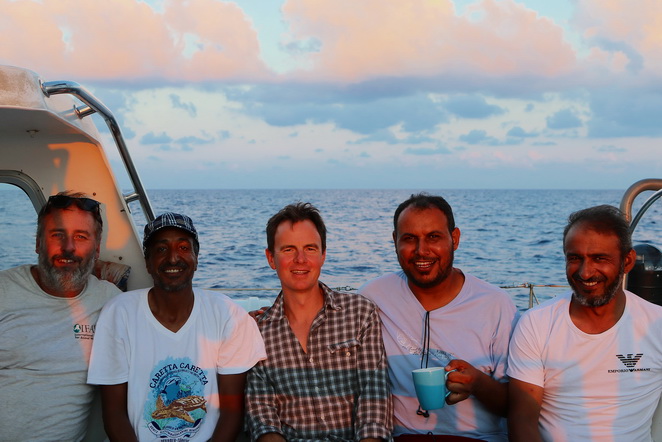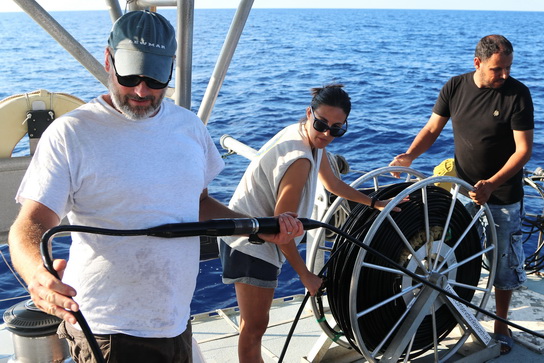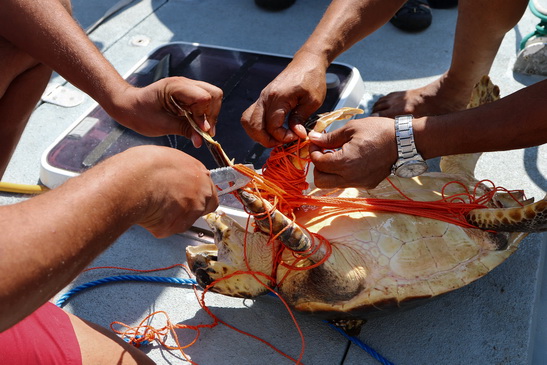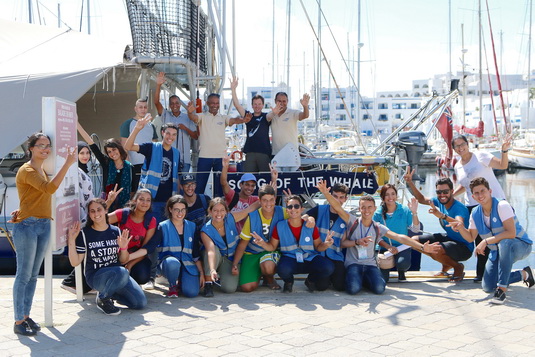Almokhtar Saied, ACCOBAMS focal point in Libya, reports in from Song of the Whale about his time on board in recent weeks.

In 2007, Song of the Whale visited Tripoli as part of a previous survey investigating the presence of sperm whales in the eastern basin. As part of the outreach and awareness programme, I visited the boat and met the crew. Together with my colleagues, I helped arrange the stay of the boat in Libya and assisted with a number of visits by dignitaries, members of the public and school groups. I even had the chance to show the team some of Libya’s historical monuments including Leptus Magna. This experience inspired me and gave me hope that one day I could visit Song of the Whale as a member of the research team.
After eleven years, Song of the Whale has returned to the eastern basin and along with my two colleagues from EGA, Salih Diryag and Mustafa Almuntasiri, I have finally had the opportunity to help survey our Libyan waters. It is a dream come true for all of us to be part of ACCOBAMS’ historic research programme, particularly as many regions in the east have historically received less survey effort. Although our team at Libya’s Environment General Authority (EGA) have compiled several years of data describing the marine mammals that have stranded along our coastline, understanding the distribution of whales and dolphins at sea is essential to provide them with adequate protection. This is particularly true in the distant offshore waters where our knowledge is most limited, despite the presence of a busy shipping corridor formed by large vessels passing through the Mediterranean Sea at high speeds. We hope that the ACCOBAMS Survey Initiative will provide the baseline data required to protect our local populations of cetaceans.

Although the trip started from Crete in quite rough conditions, the seas soon settled down as we headed south to Libyan waters. We soon found a rhythm to life on board Song of the Whale and enjoyed working alongside the rest of the Song of the Whale team. Over the course of the following two weeks at sea, we saw striped dolphins and bottlenose dolphins. We additionally heard the loud clicks of sperm whales near the Herodotus Seamount; for many of us on board, this was the first time we had heard the loudest creature on the planet. Although we were not able to hear the ultrasonic clicks of beaked whales, we were able to see their characteristic forms on the survey computers using the specialised software on board. Again, a first for many of us on board. Unfortunately, we also encountered a juvenile loggerhead turtle entangled in a fish aggregating device left drifting on the high seas. Despite the turtle’s flippers being tightly bound together by a plastic rope, we were able to cut it free and release it back in to the wild. We hope it is recovering well.

After two weeks at sea, mostly out of sight of land, we were pleased to see the coastline appearing of Tunisia on the horizon early on the last morning. After negotiating the numerous fish farms on the approach to Monastir, we tie up in the marina and our greeted by our colleagues from Association Notre Grand Bleu. Our survey has incorporated 1500 nautical miles of survey effort and we feel proud to have contributed to such an important project. In the process, we have also learnt many things and made new friends. We are hoping we will be able to continue using the research techniques we have learnt on board in our own future work. We would like to extend our thanks to ACCOBAMS, the Song of the Whale team and Association Notre Grand Bleu and hope to be involved in further successful collaborative projects such as this in the future.


solars.biz